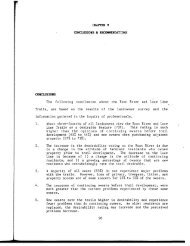Trail Maintenance and Operation - Rails-to-Trails Conservancy
Trail Maintenance and Operation - Rails-to-Trails Conservancy
Trail Maintenance and Operation - Rails-to-Trails Conservancy
Create successful ePaper yourself
Turn your PDF publications into a flip-book with our unique Google optimized e-Paper software.
So, how should the trail surface selection be made?<br />
The short answer is that this is not a design or construction<br />
report. However, some general guidance can be<br />
offered. While maintenance costs probably should not<br />
be a fac<strong>to</strong>r in the decision, construction <strong>and</strong> reconstruction<br />
costs almost certainly should be. Construction<br />
costs are beyond the scope of this study. However, nonasphalt<br />
trails require significant re-grading or resurfacing<br />
twice as often as asphalt trails (9 years vs. 17 years).<br />
A simplistic cost approach would then say, if asphalt<br />
is less than twice the cost, it is a more cost-effective,<br />
long-term choice. At least one other area of consideration<br />
should be suitability <strong>to</strong> purpose. In this regard,<br />
there are many fac<strong>to</strong>rs that come in<strong>to</strong> play:<br />
➺<br />
➺<br />
➺<br />
Volume of use—high volumes of use will<br />
arguably have a greater impact on non-asphalt<br />
trails, although there are numerous examples<br />
of well-constructed non-asphalt trails that hold<br />
up well under relatively high use.<br />
Types of use—different trail surfaces will be<br />
better or worse for different activities, for<br />
example in-line skating or equestrian activities.<br />
How do you expect the trail <strong>to</strong> be used? Are<br />
there any uses you specifically want <strong>to</strong> include<br />
or exclude?<br />
Setting—asphalt may be more fitting for an<br />
urban setting than a rural setting. Also consider<br />
environmental <strong>and</strong> aesthetic fac<strong>to</strong>rs such as<br />
the need <strong>to</strong> be consistent with a natural or<br />
his<strong>to</strong>ric setting.<br />
Is it the End of the <strong>Trail</strong><br />
OR JUST THE BEGINNING FOR COAL COMBUSTION BYPRODUCTS (CCB)?<br />
In 2001 the U.S. Department of Energy’s National Energy<br />
Technology Labora<strong>to</strong>ry (NETL) conducted a demonstration<br />
project <strong>to</strong> highlight the use of recycling coal combustion<br />
byproducts (CCB) by utilizing them as trail surfacing<br />
in an extension <strong>to</strong> the Youghiogheny River <strong>Trail</strong> near<br />
McKeesport, Pa. A portion of the trail, the Allegheny<br />
L<strong>and</strong> Trust’s “Dead Man’s Hollow Nature Area,” in Lincoln<br />
Borough was completed using six experimental trail<br />
surface sections each containing different CCB-based<br />
mixtures. NETL contracted with GAI Consultants, Inc., in<br />
Pittsburgh <strong>to</strong> design the trail surface, oversee the process<br />
for making the CCB mixtures containing coal waste from<br />
local utilities, <strong>and</strong> moni<strong>to</strong>r <strong>and</strong> report on the durability of<br />
each mixture.<br />
Periodic inspections by GAI have shown that the trail<br />
surfaces are durable <strong>and</strong> have demonstrated minimal wear<br />
since the completion of construction in 2001. During a<br />
recent inspection of the trail surfaces by Thomas Gray, PE<br />
of GAI (see pho<strong>to</strong> above), he stated that, “The trail surfaces<br />
have held up remarkably well over the past three<br />
years, <strong>and</strong> show no signs of excessive wear or cracking.”<br />
It is important <strong>to</strong> note that CCBs have also been<br />
used in other local Pennsylvania rails-<strong>to</strong>-trails projects<br />
including 1,500 feet of the Steel Valley <strong>Trail</strong> in Glassport,<br />
PA. NETL’s research in<strong>to</strong> CCB surfacing materials promises<br />
<strong>to</strong> provide environmentally sound, cost-effective trailsurfacing<br />
options <strong>to</strong> more than 2,000 miles of walking<br />
trails <strong>and</strong> light-duty pavement in Ohio, Pennsylvania <strong>and</strong><br />
West Virginia.<br />
Demonstrating the use of CCBs from local coal<br />
plants helps <strong>to</strong> reduce the need for l<strong>and</strong>fill disposal, <strong>and</strong><br />
provides an efficient <strong>and</strong> cost effective alternative <strong>to</strong><br />
crushed limes<strong>to</strong>ne, concrete or asphalt. In fact the surface,<br />
harder, smoother <strong>and</strong> stronger than crushed limes<strong>to</strong>ne,<br />
is about half the cost of concrete or asphalt. The<br />
overall results of this study could lead <strong>to</strong> the start of a<br />
whole new path for rails-<strong>to</strong>-trails projects everywhere.<br />
Youghiogheny River <strong>Trail</strong>, Pa. (Thomas Gray, P.E.)<br />
RAILS-TO-TRAILS CONSERVANCY • 13







